Week 2 Blog Post
Autumn Mists
I find interpreting silent films fascinating, especially since I grew up watching sound cinema. Watching silent films comes with a challenge, however, of relying solely on imagery to understand a silent films meaning. This challenge arises while interpreting Brumes d’automne by Dimitri Kirsanoff, but I believe I’ve gathered a good comprehension of the twelve minute silent film.
While there is no established plot outside of the audience’s perspective, the film does include a very poetic story. I believe this film is about a person’s emotional experience with the loss of love. This experience is expressed through intricate montaging techniques and visual storytelling as the world around the main character distorts and blurs. Close ups, stills, panning, transitional shots, film distortion and blur, just to name a few forms of editing this film employs. This love seems to be potentially romantic given the time period this film was made. Various scenes also suggest this theme, including the burning of letters, the shaking of hands with a figure, the scenes of a person leaving a house, and the close up shots of the main character tearing up.
I managed to get a few screenshots to note the scenes I mentioned above to illustrate my reasoning behind my interpretation of the films plot. To start, we have the scenes where the woman is clutching letters that they ultimately burn in the fireplace.
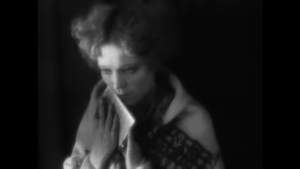


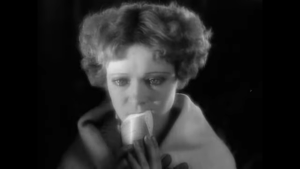
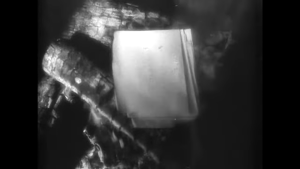
The woman seems reluctant at first to dispose of the letters as she holds onto them for multiple beats. The film shoots from the shoulders up in these scenes, allowing the audience to see the characters whole face and movements with the letters. For these particular scenes, the spatial shots work well to convey this type of emotion.
A montage then follows the rest of the film as we see the woman shake hands with someone, the camera holding position until the hands slowly slip away from one another leaving the woman still in frame. Cut then to a person leaving a building while a piece of paper falls out of their pocket. Then cutting back to the woman, then back again, and so on until the whole scene changes.
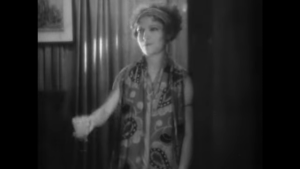

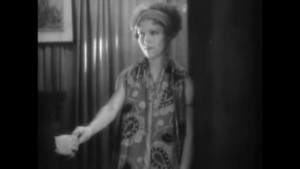
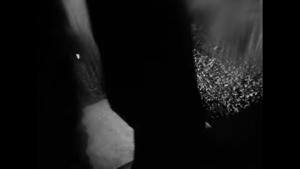
Once again, the film’s editing succeeds at conveying the emotion of the woman as we experience her point of view while the figure, assumedly lover, leaves her. Sudden, confusing, and without explanation.
Next up are the usages of montage express the woman’s feelings after her loss of love. So much so that film depicts scenes of nature with a lens distortion/blur while cutting to the woman staring into the distance. Much like the technique we discussed in class where directors will transition scenes based on where the character in the previous scene is looking. The film then cuts and follows the woman walking through the woods while cutting to a scene of a leaf flowing in water. These scenes could be depicting the woman flowing through her emotions and finding some form of acceptance through nature. Once again, here are some screenshots of said scenes.
Camera rotates the shot of the water, cuts back to woman.
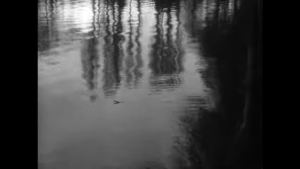

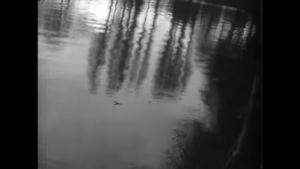
Shot of the lake blurs and distorts, almost a radial blur.
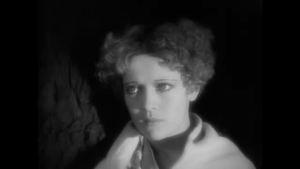
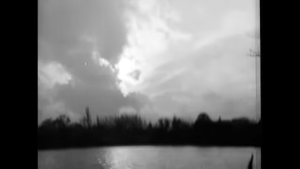
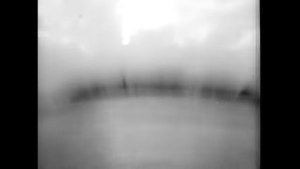

Shot drastically changes into something jagged and sharp.


.
A shot of a tree slowly blurs and appears somewhat human-like as it cuts to the woman closing her eyes.
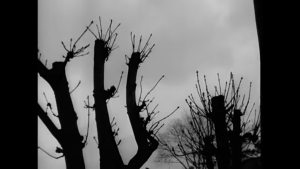
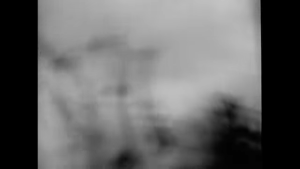
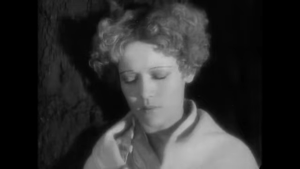
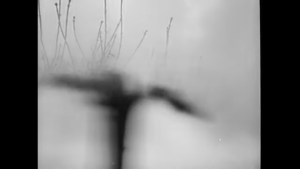
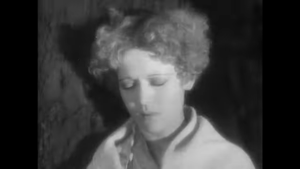
A simple shot of a dock as the camera blurs cutting back to the woman opening her eyes.
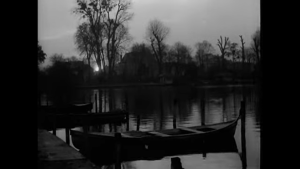

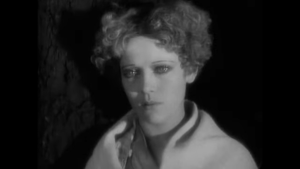
The last few scenes of the woman walking down a river and a leaf flowing down a river. A comparison shot of the two.
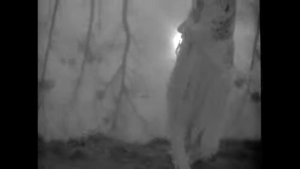

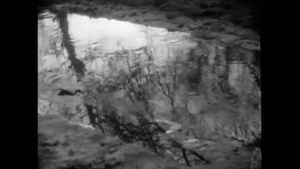
Overall, Autumn Mists tells a melancholy story through the thoughts of the main character and very intricate film editing.
Thanks for reading,
-Caleb
Making Space Video
I had some issues coming up with a concept or story that could help depict continuity editing. Though, I feel this video of me making and enjoying a cup of coffee worked with the overall technique needed for this video. I tried to keep the coffee mug in the same hand for every different walking scene. Also, I picked up the coffee mug using the same hand that I am walking and holding the coffee mug in for those scenes.
-Quincy
ruln lola run
The movie uses many different strategies to keep the story coherent. One of the many things that the director chose to do to keep this film from falling apart was repetition. It is crucial to pay attention to the order of events used to pace all three timelines. It is made apparent that everything that happens will happen again. But, each shot is slightly altered to keep the story fresh but also to make each outcome or conclusion to the story different. Looking back at some of the shots they share the same framing techniques used for the other iterations of the story. A prime example of this is when Lola runs past the old lady with the baby stroller, all three shots of that incident utilize the same camera work. I think that these small things make the film digestible and easy to understand regardless of its abstract creative vision.
Run Lola Run Blog Post
I thought Run Lola Run, despite that it jumps around, keeps the narrative moving and keeps the narrative clear to the audience. I think for one, it makes it easy to understand because when someone dies, the very beginning plays again, which is familiar to the audience. But, instead of the character doing the exact same thing, each time they die they try something slightly different that helps them progress further into the story. For example, after Manny and Lola rob the convenience store, it ends with Lola getting shot. The movie starts back with the phone falling and Lola running out of her apartment, which is familiar to the audience. The whole rest of the movie is essentially the same, but instead of robbing the convenience store, she runs to the bank her father owns to rob that instead, which progresses the story further.
WEEK 2: Run Lola Run
Blog Prompt:
Although Run Lola Run has a discontinuous style – made of many types of cinematic images, including color, black and white, animation, video and still shots – it is held together as a whole by following rules of continuity to keep the viewer oriented in the fragmented spaces and times.
How does the movie retain narrative momentum despite all the time shifts? What narrative forces/desires drives the edits of shot to shot? In what ways is time “stretched” or “compressed” and how is the effect achieved? These questions are only “prompts” for your own thoughts about the narrative, cinematography and editing styles of the Run Lola Run. Take screen grabs to support your thoughts.
———-

Throughout this narrative, the momentum is sustained through the repetition of scenes with, time pressure, music, and dynamic cinematography. The film’s discontinuous style primarily focuses on three different scenarios with slight variations, creating a structure that propels the story forward. Lola’s race against time to save her boyfriend serves as the central force, influencing the director’s choices of quick cuts, specific camera movements, and unconventional shots. The music further amplifies the urgency of her mission to rescue her boyfriend. Additionally, the film employs time loops, montage, and split screens, contributing to its non-linear structure.

30 Second Day
My 30 second day video I wanted to showcase my snow day off. Unfortunately due to the weather my tri-pod phone stand arrived late so I had to get creative with how I filmed my shots. I wanted to showcase time lapse shots of the day changing from morning to day and from day to night. The tasks in between are my usual chores such as doing the dishes, keeping up with laundry, and cooking dinner along with playing a video game. I am no professional when it comes to filming something like this, to be honest it was my first attempt at this idea. I think it was a cool exercise and I tried to incorporate a mixture of video filmed moments and still photos to tell the story.
-Quincy
30 Seconds of the Day
Run Lola Run Blog Post
Run Lola Run was an interesting movie with the main focus being Lola with her presence affecting everyone around her. The beginning sequence establishes that Lola running to her destination is the main focus, some side characters will have some part to play within the storyline. The first time around, when Lola making the receiver land on the phone, the shot gives emphasis on the phone. This is later shown to be the beginning of the time loop when a traumatic event occurs to Lola.

After the beginning sequence, it show Lola beginning her run in an animated form until she exits the building with each animated part that occurs being different. On the second loop, it gives the audience a clue that Lola’s actions will be different although uncertain to how much. From her surroundings to her interactions with others are affected with each loop from where she meets them within her run to their interaction with her. While each loop looks similar at a first glance, no two interactions are the exact same.
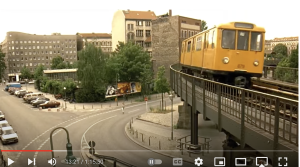
First Loop
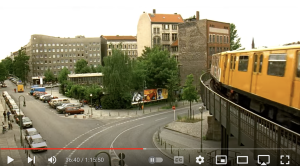
Second Loop
This is also true for the people Lola interacted with from their stories within the loop. On the first loop, each of the side characters had a tragic backstory that led to their current lives. As the loops continue to occur and Lola interacting with them, their stories get better. This shows that Lola’s interaction with those people have improved due to the new loop and
Lola’s own goals improve with each loop.

First Loop
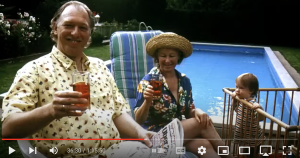
Second Loop
Overall, the directors executed a well though-out storytelling method with an established time loop method. While some parts did not make sense on a normal occurrence, they still fit within the storytelling. The directors also kept the lengths of each of the loops exactly the same length to give further meaning to the time frame given with the movie. Run Lola Run is an enjoyable movie for viewers.
Week One Blog – Run Lola Run
Run Lola Run is by far one of the most unique or creative movies I have seen when it comes to the way it portrays and tells its evolving story. Right away you understand the story when the phone call between Lola and Manni comes to an end. From here on, the story seems to be rather straightforward with some sad/upsetting moments in it. You would hope and think it will wrap up with a happy ending, maybe with the two running away together. That’s what I had thought at first, that is until the main character we follow, Lola, suddenly gets shot and dies in front of Manni.
Suddenly we are sent back to when the phone was first hung up by Lola, the same scene plays as she’s running out the door. Afterwards, things almost feel the same so you think it will end the same. However, there are slight differences with different outcomes that lead to changes in the ending. She keeps getting faster with each reset and thus changes the story’s ending.
All of this, her being faster, is hinted at throughout each phase. From the variation in the way things are shot or the actions taken by Lola. A great example of this is the animation section that plays when she is running down the stairs at the beginning of each reset. The first go is rather straightforward but seems to take quite a while, while the second is interrupted by her getting tripped and falling down said stairs, injuring herself. Finally, in the last run, she clears it in the shortest amount of time. Avoiding the obstacles and getting an incredible amount of extra time, time that came in handy when she made a risky gamble to win the money.
Run Lola Run Post
In the movie Run Lola Run momentum is held with looping and the use of certain events that are used to anchor the viewer.
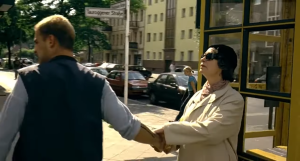
Black and White, Photos and Music are also used as ways of flashback and inner monologues to give an incite to how Lola is feeling during her runs.
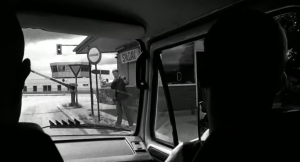
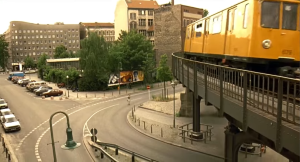
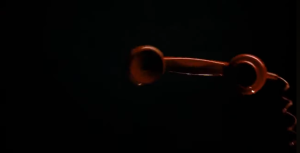
The beginning of the movie has a sort of Overture of shots that give the viewer an idea of the filming techniques that are to come and be used through out the movie. This helps the audience locked into the story that is happening without confusion. Their is always an animated sequence that starts of the 20 minute segment of the movie.
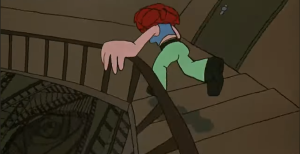
Their is small variations to this sequence that can show how this coming segment of the film maybe effected. the first segment teaches the audience what needs to be done within the 20 minute time. An example that comes to mind is the second attempt at helping Manni were in the starting of this sequence the child trips Lola and that makes her late to certain events and has ultimately a bad outcome for her. Another tool that is used is still photography sequences that show more about the characters and how they are effected by how Lola’s attempts to help Manni. Showing where Lola is in sequence to her 20 minute deadline.
Run Lola Run
Run Lola Run was a very fun movie to watch and I thought the director did a very good job keeping up the narrative momentum while also have many discontinuous shots and playing with the timeline of the movie. The opening scene includes an animated part where she is running down the stairs, and it does a good job of moving in between live action and the animation. We know that this scene is continuing from the live action because of the way it was set up. We see her running for the stairs and assume that this animation part is continuing the from the live action and fades back into live action when she opens the door.

The movie also has a recurring time loop that is shown by running the opening sequence every time a new loop starts. This helps us get our bearings and understand that this sequence of events is going to be different this time. Overall, most of the time loops are very similar, with only a few main differences, and a few smaller differences in how she interacts with people she passes.
When we see these people she interacts with, there is sometimes a pause in time where we can see how their interaction has changed the outcome of their future. Their future is shown by a quick sequence of pictures of what they are going to do or what happens in their life.

While this doesn’t add much to story itself, it does show that she is re-living the moment in time when she interacts with these people, multiple times throughout the movie. Their futures change depending on how their interaction is.
Day in 30 Seconds
Run Lola Run Blog Post
Run Lola Run retains narrative momentum by both establishing its metaphysical defiance early and by using an array of compositions, camera movements, and types of cuts to weave its images into continuity. Most obvious is the use of the “red phone” image, which slams itself down upon reset of each timeline.
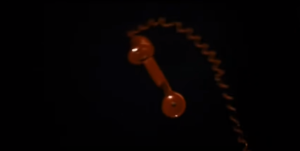
It also repeats an animation and the event of Lola scrambling down the apartment hallway at the beginning. It is not enough to merely repeat the events, however- the composition and camera movements are meticulously imitated, invoking that sense of Deja-vu as the timelines reset and converge. The camera diverges from Lola at the end of the hall, sweeping into a new room where an elderly woman speaking on the phone becomes our new subject. In one timeline, we glide right past her and into the television; As the narrative becomes more frantic, the camera spins erratically before entering the television. As we become more entrenched in the repeated rules and cinematic gestures of the timeline, the film becomes more comfortable breaking them.
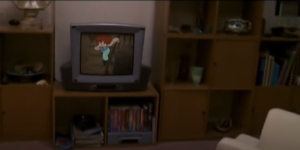
One of the more fascinating edits in the movie sees Lola sprinting, the frame interrupted by pillars splitting the image, and occasionally we intercut for a fractional second and see Lola’s face as she runs. A cut is a way to conceal many things, but in this case it is a dilation of time- Run Lola Run frequently manipulate geography with cutting, but these cuts also switch the shots from wide to close, allowing a greater emotional insight and distressing tone.
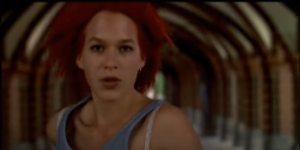
Run Lola Run is a dense example of the way cutting, composition, images, and editing can allow an audience to understand the spatial and temporal manipulation of a story.
One Day Assignment